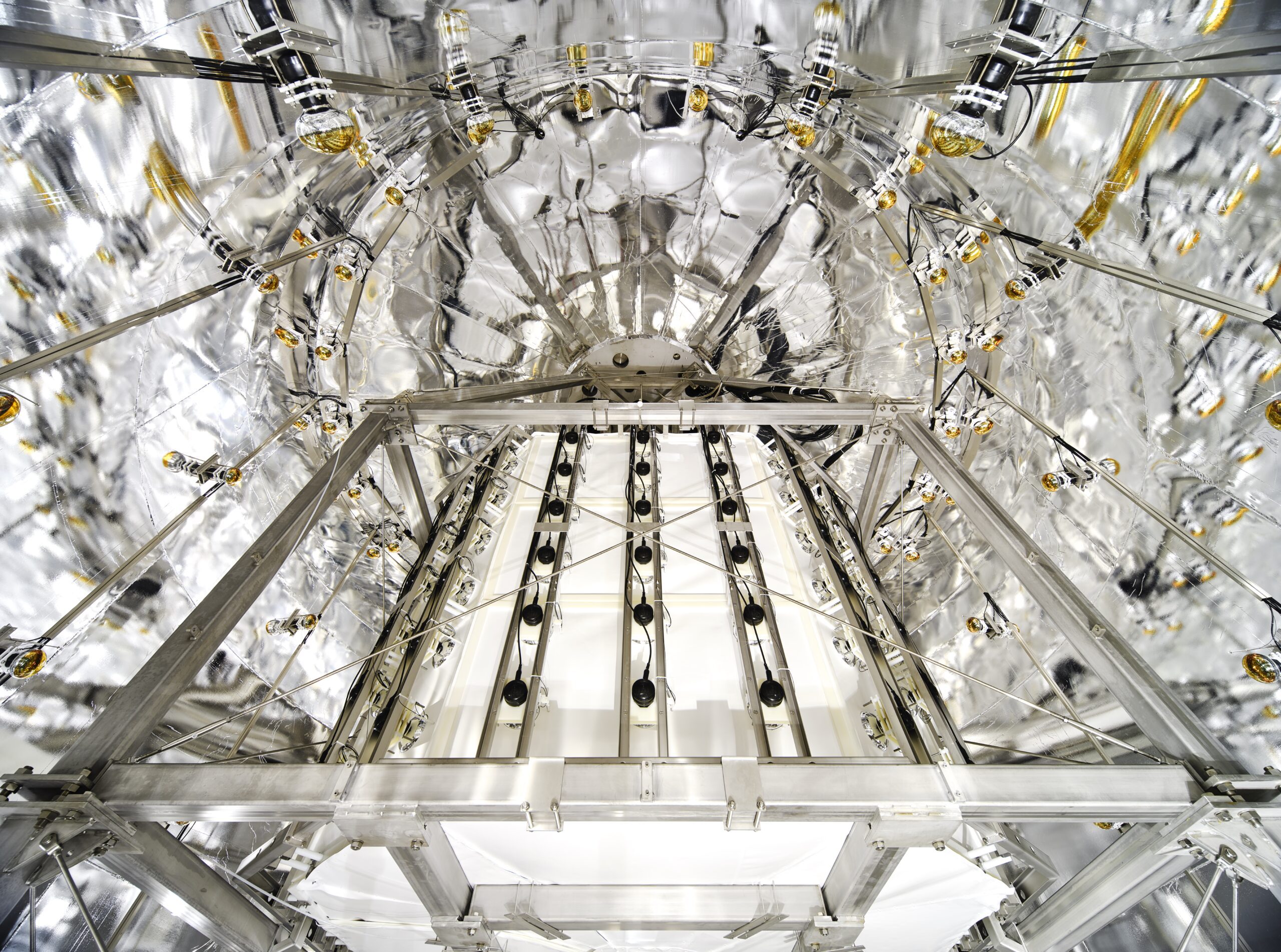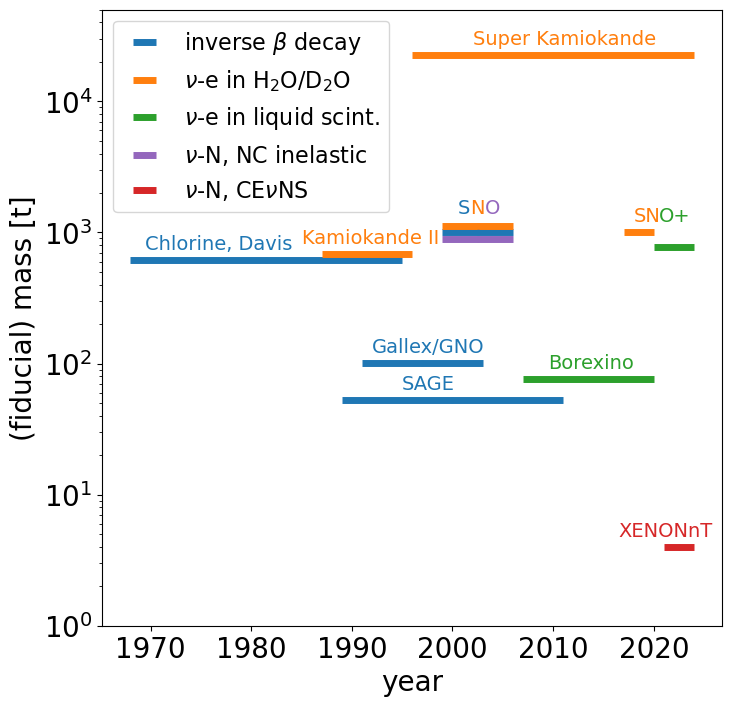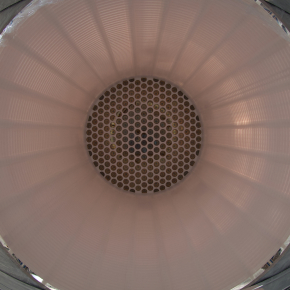The XENONnT experiment opens a new era in neutrino astronomy
At the IDM conference in L'Aquila, the XENON collaboration, in which IN2P3 participates, announced that it had detected and identified the passage of solar neutrinos. This type of detection, extremely rare and normally reserved for detectors 10 to 50 times larger, was made possible by the extreme sensitivity of the detector, designed to detect dark matter. It is so sensitive that it can feel not only the nuclear reactions between neutrinos and the constituents of the nucleus, but also the much more frequent tiny shocks that certain neutrinos inflict on the nucleus as a whole. A phenomenon that could revolutionise neutrino astronomy.
Inside the XENONnT dark matter detector, nestled 1400 m beneath the Apennines in Italy, 5.9 tonnes of ultra-pure liquid xenon await possible interactions with dark matter particles. To date, the XENON collaboration has seen no evidence of such interactions. However, on 10 July, at the IDM (International Workshop on the Identification of Dark Matter) conference, it announced that it had detected another phenomenon that was almost as astounding. In the absence of dark matter particles, the detector detected the tiny, almost imperceptible "jostles" between solar neutrinos and the xenon nuclei in the experiment. This phenomenon is known as "coherent elastic neutrino scattering on nuclei", or CEνNS. Theoretical physicists had envisaged it as early as 1974, but it is so discreet that it was not until 2017 that it was experimentally demonstrated by the COHERENT experiment using the flux of artificial neutrinos produced at the Oak Ridge neutron facility (ORNL, Tennessee, USA). With the announcement of the XENON collaboration, this is the very first time that this phenomenon has been observed with neutrinos of natural origin. A first that opens up interesting prospects for neutrino astronomy, an astronomy that studies stars not according to the waves they emit, but according to the neutrinos that emerge from them.

The experiment is sensitive to solar neutrinos
Fusion reactions at the heart of the Sun produce phenomenal quantities of neutrinos, which can tell us a lot about the phenomena at work within our star. Unfortunately, these particles only interact very weakly with matter, and neutrino detectors, despite their gigantic size, only manage to see them very rarely. They all use more or less the same method, which is to observe large volumes of liquid where they wait for the neutrinos to react with a proton, neutron or electron and produce a detectable reaction. A reaction that has an extremely low probability of occurring. And this is where the detection technique used by the XENON experiment changes everything. Elastic scattering on nuclei occurs much more frequently and neutrino detection therefore becomes within the reach of smaller detectors made up of large target nuclei such as xenon nuclei.
The results of the XENONnT experiment speak for themselves. In their detector, the scientists were looking for neutrinos produced by the decay of boron 8 into beryllium 8, a reaction that is both fairly frequent in the Sun and produces the most energetic solar neutrinos, around 10 MeV. In a way, these are the neutrinos that are easiest to see. The flux of these neutrinos leaving the Sun and passing through us was estimated by the SNO experiment (Canada) in 2001 at 2.5 million particles per square centimetre per second. At the time, SNO was using a detector weighing 1,000 tonnes of heavy water. The same flux is measured today by XENONnT with just 5.9 tonnes of active xenon mass.


Of course, detecting this signal is not within the reach of just any detector. It is because it was designed to detect the much rarer signal of dark matter particles that the XENONnT detector was able to achieve this feat. We knew that cosmic neutrinos could interact with the cores of our detector in this way, so we dedicated a research programme to this observation," comments Luca Scotto Lavina, researcher at the LPNHE and head of the XENON project at IN2P3. The predecessor of the current experiment, XENON1T, had already tried to capture neutrino signals, but without success, because the sensitivity of the detector was not sufficient to distinguish neutrinos from background noise that was too high. With XENONnT, this is now possible". But it still took two years of measurements to finally observe a surplus of around ten events attributable to CEνNS.
A neutrino astronomy observatory in the making
Understandably, to herald the real advent of neutrino astronomy, detectors larger than XENONnT will have to be built. Like its successor, the XLZD detector should take over in the 2030s with 40 tonnes of xenon. If XENONnT can estimate the flux of boron 8 neutrinos to within 12%, XLZD will be able to do so to within 1%," explains Luca Scotto Lavina. The larger the detector, the more events occur. With XLZD, we'll be able to see boron-8 neutrinos more clearly, but we'll also be able to see other rarer or less energetic neutrinos from other reactions or phenomena, such as the proton-proton chain reactions that are the Sun's main fuel, or the reactions that produce nitrogen, carbon and oxygen in the star. And, beyond our star, we can envisage the detection of neutrinos from core-collapse supernovas, or even neutrinos from the diffuse supernova background. Beyond being a 'hunter' of dark matter, the XLZD detector will have the potential to open up a new chapter and form the experimental cornerstone of a future detailed understanding of the cosmos and the Universe thanks to neutrino astronomy.
About the XENONnT experiment
Around 200 scientists from more than 25 institutions around the world make up the international XENON collaboration, representing more than 25 different nationalities. Since 2006, this collaboration has been searching for dark matter using liquid xenon time-projection chambers in a series of experiments: XENON10, XENON100, XENON1T and XENONnT.
The XENONnT experiment has been designed to search for dark matter particles with a sensitivity that is an order of magnitude greater than that of its predecessor. The cylindrical detector at the heart of the experiment is a Time Projection Chamber (TPC). Approximately 1.5 metres in height and diameter, it is filled with ultra-pure liquid xenon maintained at -95°C. A mass of 5900 kg of xenon out of the 8600 kg needed to operate the detector constitutes the active target for interactions with particles. It is installed inside a Cherenkov veto for muons and neutrons, deep inside the Gran Sasso National Laboratories (INFN) in Italy. XENONnT was built and commissioned between spring 2020 and spring 2021.
In France, IN2P3 has been involved in this project since 2009 through two of its laboratories: LPNHE (Paris) and SUBATECH (Nantes).
Find out more
Read the collaboration's press release : in French – in English
Presentation of the results at IDM
Website of the XENON collaboration : https://xenonexperiment.org/
